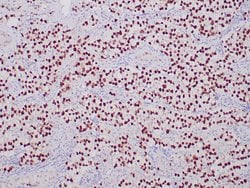Promotional price valid on web orders only. Your contract pricing may differ. Interested in signing up for a dedicated account number?
Learn More
Learn More
SALL4 Recombinant Rabbit Monoclonal Antibody (ZR276), RAbMono™, Zeta
Rabbit Recombinant Monoclonal Antibody
$88.05
Specifications
| Antigen | SALL4 |
|---|---|
| Clone | ZR276 |
| Concentration | 100 μg/mL |
| Applications | Immunohistochemistry (Paraffin) |
| Classification | Recombinant Monoclonal |
| Catalog Number | Mfr. No. | Quantity | Price | Quantity & Availability | |||||
|---|---|---|---|---|---|---|---|---|---|
| Catalog Number | Mfr. No. | Quantity | Price | Quantity & Availability | |||||
50-223-8246

|
ZETA CORPORATION
Z2726RT |
100 μL |
Each of 1 for $88.05
|
|
|||||
Description
This product is diluted and in a ready-to-use formulation.
A recommended positive control tissue for this product is Seminoma, however positive controls are not limited to this tissue type. The primary antibody is intended for laboratory professional use in the detection of the corresponding protein in formalin-fixed, paraffin-embedded tissue stained in manual qualitative immunohistochemistry (IHC) testing. This antibody is intended to be used after the primary diagnosis of tumor has been made by conventional histopathology using non-immunological histochemical stains. Antibody is used with formalin-fixed and paraffin-embedded sections. Pretreatment of deparaffinized tissue with heat-induced epitope retrieval or enzymatic retrieval is recommended. In general, immunohistochemical (IHC) staining techniques allow for the visualization of antigens via the sequential application of a specific antibody to the antigen (primary antibody), a secondary antibody to the primary antibody (link antibody), an enzyme complex and a chromogenic substrate with interposed washing steps. The enzymatic activation of the chromogen results in a visible reaction product at the antigen site. Results are interpreted using a light microscope and aid in the differential diagnosis of pathophysiological processes, which may or may not be associated with a particular antigen. A positive tissue control must be run with every staining procedure performed. This tissue may contain both positive and negative staining cells or tissue components and serve as both the positive and negative control tissue. External Positive control materials should be fresh autopsy/biopsy/surgical specimens fixed, processed and embedded as soon as possible in the same manner as the patient sample (s). Positive tissue controls are indicative of correctly prepared tissues and proper staining methods. The tissues used for the external positive control materials should be selected from the patient specimens with well-characterized low levels of the positive target activity that gives weak positive staining. The low level of positivity for external positive controls is designed to ensure detection of subtle changes in the primary antibody sensitivity from instability or problems with the staining methodology. A tissue with weak positive staining is more suitable for optimal quality control and for detecting minor levels of reagent degradation. Internal or external negative control tissue may be used depending on the guidelines and policies that govern the organization to which the end user belongs to. The variety of cell types present in many tissue sections offers internal negative control sites, but this should be verified by the user. The components that do not stain should demonstrate the absence of specific staining, and provide an indication of non-specific background staining. If specific staining occurs in the negative tissue control sites, results with the patient specimens must be considered invalid.Specifications
| SALL4 | |
| 100 μg/mL | |
| Recombinant Monoclonal | |
| Liquid | |
| RUO | |
| tris with BSA, NP-40 and <0.1% sodium azide | |
| 5730441M18Rik; AA407717; AL022809; AW536104; C330011P20Rik; C78083; C78563; dJ1112F19.1; DRRS; HSAL4; SALL4; sal-like 4; sal-like 4 (Drosophila); sal-like protein 4; spalt like transcription factor 4; spalt-like transcription factor 4; Tex20; Zinc finger protein 797; zinc finger protein SALL4; ZNF797 | |
| SALL4 | |
| IgG | |
| Protein A | |
| Antibody |
| ZR276 | |
| Immunohistochemistry (Paraffin) | |
| Unconjugated | |
| Rabbit | |
| Human | |
| Q9UJQ4 | |
| 57167 | |
| Recombinant fragment (around aa1-185) of human MIC2 protein | |
| Primary | |
| 2-8°C | |
| SALL4 |
Spot an opportunity for improvement?Share a Content Correction
Product Content Correction
The Fisher Scientific Encompass Program offers items which are not part of our distribution portfolio. These products typically do not have pictures or detailed descriptions. However, we are committed to improving your shopping experience. Please use the form below to provide feedback related to the content on this product.
Product Title
